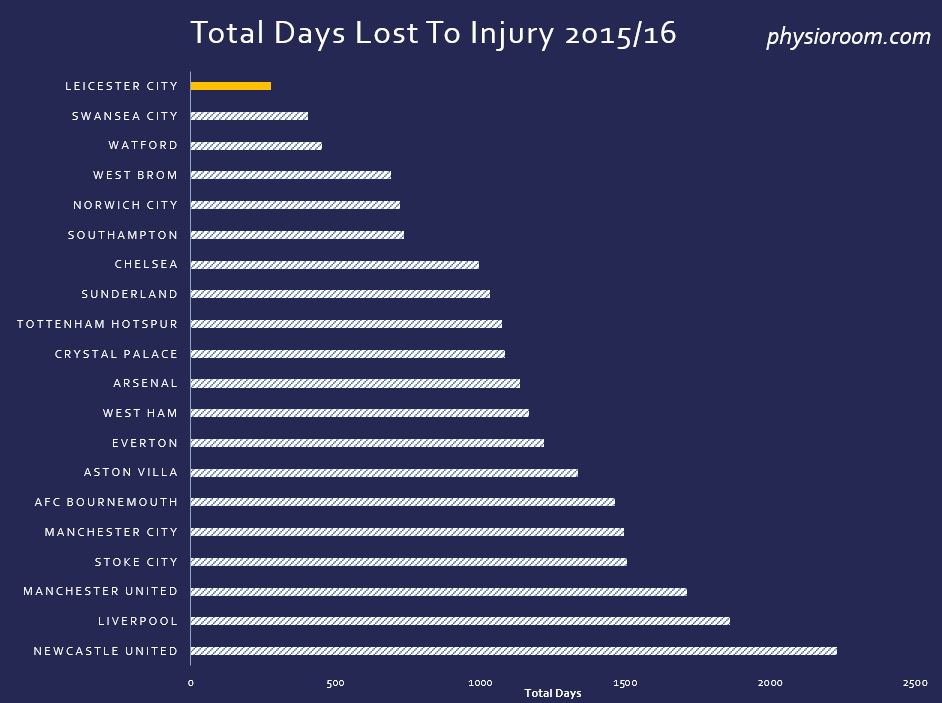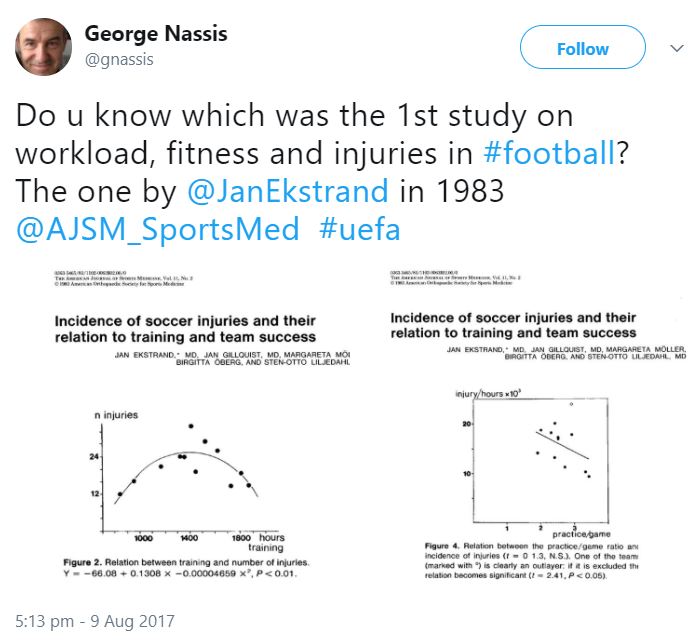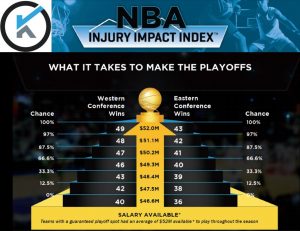Does Injury Availability Affect your Team’s Chance of Success?
The 2017/18 Premier League season has officially kicked off and so, therefore, have the injury statistic leagues. It has long been suggested that injury rates and player availability affect a team’s chance of success. This is not just the speculation of pundits or those down the pub; we have evidence to support this notion. We’ll explore some within this blog.
Premier League Narratives
Firstly, there are a number of anecdotal examples of this relationship. The last two Premier League Champions, Leicester City (2015/16) and Chelsea (2016/17), were first and second respectively in Physio Room’s league table for total days lost to injury.
http://www.physioroom.com/news/english_premier_league/2015_16/injury_analysis.php
http://www.physioroom.com/info/english-premier-league-injury-analysis-201617-season/
While we should acknowledge the potential limitations of publicly available injury data, I believe it is still worthwhile information.

Would Leicester have been able to pull off the most incredible season in football (overcoming odds of 5000/1) if Kante, Mahrez or Vardy had suffered more injuries? Would Chelsea have taken their crown if Kante (common denominator!), Costa or Azpilicueta (who played every minute last season) had been less available?
Having your players available allows the coach to pick from the best players and with that, we also see a pattern of consistency in the starting teams. Claudio Ranieri was able to repeatedly name the same starting eleven and Leicester City used the fewest number of players across the whole season in the Premier League that year: http://www.bbc.com/sport/football/36166146. Similarly, Chelsea made minimal changes to their starting line-up last season, except for the final two games when the title was already wrapped up: http://www.thestatszone.com/articles/how-many-line-up-changes-did-each-premier-league-club-make-during-2016-17
Backed by Science?
 Those statistics are of course nice for media articles and commentators but what about published scientific literature on the potential association between injuries and success? Dr John Orchard highlighted this in 2009 when he wrote that “player durability” (match availability) is a key component to success in his “Moneyball” discussions here. However, our evidence stems back further than that as George Nassis pointed out on Twitter just last week! In 1983, Jan Ekstrand and colleagues published evidence here in the American Journal of Sports Medicine of a direct correlation between team success and the amount of training; a higher practice-to-game-ratio was associated with a reducing number of injuries.
Those statistics are of course nice for media articles and commentators but what about published scientific literature on the potential association between injuries and success? Dr John Orchard highlighted this in 2009 when he wrote that “player durability” (match availability) is a key component to success in his “Moneyball” discussions here. However, our evidence stems back further than that as George Nassis pointed out on Twitter just last week! In 1983, Jan Ekstrand and colleagues published evidence here in the American Journal of Sports Medicine of a direct correlation between team success and the amount of training; a higher practice-to-game-ratio was associated with a reducing number of injuries.
Jan and his colleagues at UEFA have continued to collect such information with the Champions League Injury Study. In an 11-year follow-up, Hägglund and colleagues found lower injury burden, lower injury incidence and higher match availability to be associated with performance, measured via metrics such as final league ranking, points per league match and success in European tournaments. The full text is available here on ResearchGate.
Beyond Football
This relationship has also been demonstrated in published research across a range of sports, including the following:
- Raysmith BP, Drew MK. Performance success or failure is influenced by weeks lost to injury and illness in elite Australian track and field athletes: A 5-year prospective study. Journal of Science and Medicine in Sport. 2016 Oct;19(10):778-83.
- Podlog L, Buhler CF, Pollack H, Hopkins PN, Burgess PR. Time trends for injuries and illness, and their relation to performance in the NBA. Journal of Science and Medicine in Sport. 2015 5;18(3):278-82.
- Eirale C, Tol JL, Farooq A, Smiley F, Chalabi H. Low injury rate strongly correlates with team success in Qatari professional football. British Journal of Sports Medicine. 2013 Aug;47(12):807-8.
- Williams S, Trewartha G, Kemp SP, Brooks JH, Fuller CW, Taylor AE, et al. Time loss injuries compromise team success in Elite Rugby Union: a 7-year prospective study. British Journal of Sports Medicine. 2016 Jun;50(11):651-6.
A recent systematic literature review by Drew, Raysmith and Charlton from the AIS surmises the findings relating to availability and team success, as well as the levels of evidence. I would highly recommend reading this paper and you can find a copy here via Researchgate.
Injuries not only make athletes unavailable for selection but they may affect the team’s chances of success in more widespread ways, such as enforcing changes to team strategy/tactics, disrupting game preparations and causing psychological effects of stress and anxiety both in the injured athlete and potentially in his/her teammates.
Some More Important than Others?
Of course, losing certain players to injury may have a bigger impact on the team’s chance of success than others. Some analyses have attempted to quantify this influence. For example, the fascinating ManGamesLost.com analysis of the big American team sports uses the Injury Impact to Team (ITT) factor. This quantifies the impact of an injury by estimating how much time the injured athlete would have played if healthy. You can read more information on the metric in the FAQ section of the site.
There are also the financial implications of injuries. According to sportingintelligence.com and Premier Injuries, the total wage bill for injured players in the Premier League last season was over £131 million. Kitman Labs have tried to combine the analysis of the effect of injuries on both team success and the financial  cost. By incorporating base salary data, they have also attempted to account for the ability of athletes. In theory, more important players should be paid more (that is not always the case but is a crude proxy).
cost. By incorporating base salary data, they have also attempted to account for the ability of athletes. In theory, more important players should be paid more (that is not always the case but is a crude proxy).
They have explored this information across the NBA, NFL, MLB, NHL and the MLS. The analyses found strong correlations between the number of wins and available athlete dollars. For example, in the NBA their analysis found teams with a guaranteed playoff spot had an average of $52 million athlete-dollars available to play throughout the season. Their injury impact index research is available to download for free.
Final Thoughts
In summary, there appears to be strong evidence of a relationship between success and injury/illness availability. Whether your team’s ownership/management is driven by bankroll or success (or both incentives), we are armed with information to support the impact injuries (and therefore avoiding injuries) can potentially have on both performance and finances. Athlete health and performance are clearly interrelated measures. However, injuries cannot be prevented altogether and there is a whole spectrum of “avoidability” (if that is a word?!) of many injuries. There is also an ongoing debate regarding how much luck plays a part in injury. For example, see the BJSM educational review by Phil Coles from the San Antonio Spurs on his injury prevention pyramid and the consequent correspondence by Sheree Bekker. But that is a debate for another day…
Evidence of an association between success and injuries can be used to help support the implementation of strategies. As Drew and colleagues state in their systematic review (2017):
“[W]hen attempting to garner support and adherence to the implementation of interventions (and ongoing participation in injury and illness prevention programmes), one way to improve engagement would be to highlight the link between injuries and impaired performance.”
However, this notion should also not be used just to justify buying more tools or employing more staff alone. The presence of “Sports Science” or “GPS” or “{insert any of the vast number of Sports Technology solutions and/or Athlete Data Management systems currently available}” on their own do not inherently reduce injury risk. It is how this information and expertise are used to decide and implement interventions that may beneficially impact injury risk and therefore potential availability and ultimately performance and team success.






Excellent summary, Jo! I’ve now found and read all of the subsequent links and now back-referencing through those. Hope you’re well!!
Thank you Peter!
Very happy to have ManGamesLost.com included in the mentions of all those other great sports injury resources.
[…] month we explored the evidence base supporting the notion that athlete availability reduces your team’s chance of su…. That post included a number of sources that demonstrated an association between injury rates and […]